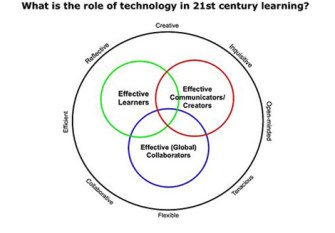Part 4 – Refining the idea and creating understanding
Yesterday we (Justin Medved and Dennis Harter) spoke about our efforts to broaden the conversation that we had been having within our department with our wider school and the leaders within it. It became very clear to us early on that unless there was a shared understanding of concepts like “21st century literacy” and why our classrooms needed to educate for it then we would be stuck in a curricular holding pattern. There is lots of talk about the need to broaden student literacy to encompass and address the skills needed to navigate the new visual and information landscape, but what does that look like in practice and how do you write it into the K-12 curriculum in a way that is manageable and meaningful.
just five questions would be much more manageable for the average teacher. These questions speak to thinking, critically evaluating, analyzing, and communicating. They value responsible behavior and knowing yourself as a learner. In a world in which it is impossible to predict what technology children will be using as adults, it is the “answers” to these five questions that will provide students the opportunity to succeed and thrive in the 21st Century. The power of these Essential Questions, lie in their applicability to all ages and to discussion more important and broad than technology standing alone.
A grade 1 teacher can and should have valuable discussions with students about being safe or recognizing truthful information. Who are the people you trust? What about them makes you believe what they say? What
makes one “source” more valuable than another? Those same questions can be asked throughout a child’s schooling, but the answers begin to include more sources and more critical examination of their world. And eventually, they begin to include technology. If experimentation and data analysis is a way to know something is true, then you will have to learn how to use the technology needed to analyze that data. If being safe is valued, then learning about responsible use of social networking sites, issues of privacy, and web 2.0 technologies inevitably will be discussed at a time appropriate to students’ use.
It was our feeling that the broad nature of these questions makes them accessible to teachers whose responsibility it is to embed this curriculum into their students’ learning.
Teachers believe that they can teach effective communication.
They don’t believe they know much about PowerPoint.
Nor should effective communication be limited to a software title anyway. The answers to these Essential Questions are higher-order thinking skills and issues of global citizenship. These are the skills we NEED students to have and the ones that will serve them well once they leave the arena of formal education.
Our google collaborative document was the perfect venue to allow this to happen. It was fascinating to watch as 12 people debated and edited the same document at the same time. What a powerful tool!
Our first challenge was to answer the question “What do we want our students to learn?” Our framework provided much of this information, but it was also important to outline what we wanted our students to be once they finished at ISB. From the perspective of this framework we all agreed that the ideas could be synthesized down to three areas.
We wanted out students to be:
Effective Learners
Effective Communicators
Effective Collaborators

From this starting point and as a result of much discussion and collaboration, we all agreed that our ideas and five essential questions could be refined further down to three new questions.
How do I responsibly use information and communication to positively contribute to my world?
How do I effectively communicate?
How do I find and use information to construct meaning and solve problems?
With these questions we then proceeded to flesh out the enduring understandings that went with them. It was our feeling that these should always be evolving to address the changing face of communication, collaboration and information. The curriculum would be in constant beta. A testament to the ever expanding nature of the skills it was attempting to map.
What do you think?
Justin Medved, Dennis Harter, Guest Bloggers
Cross Posted at: Medagogy and Thinking Allowed
Tomorrow’s post:Part 5 – Moving forward – from rhetoric to reality.





